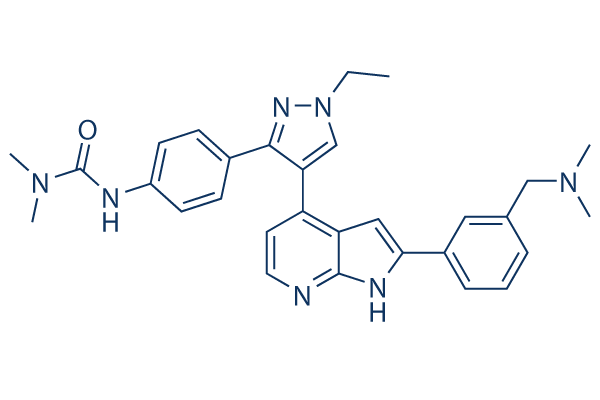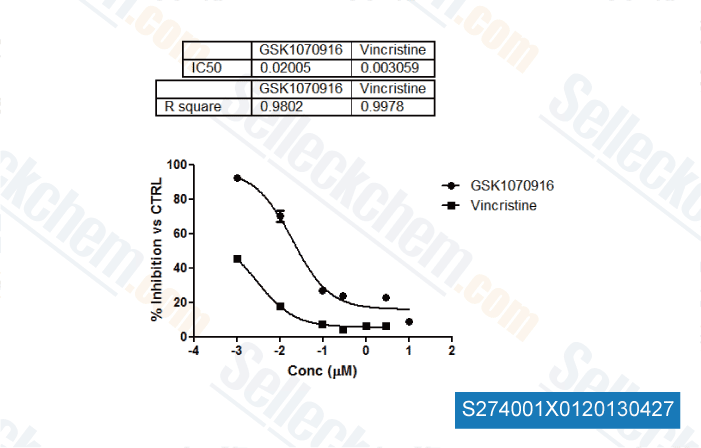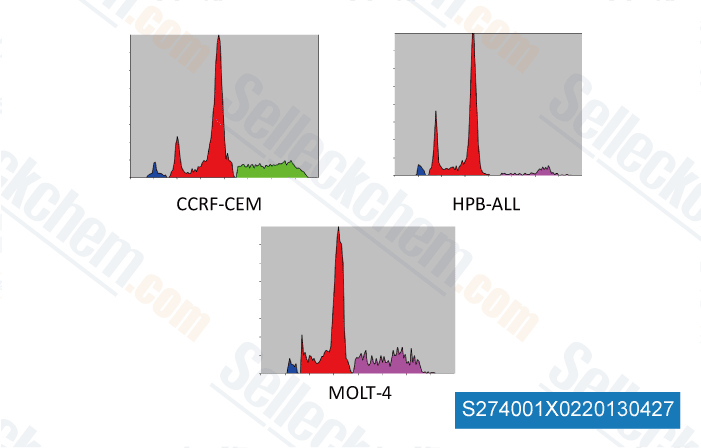|
受注:045-509-1970 |
技術サポート:[email protected] 平日9:00〜18:00 1営業日以内にご連絡を差し上げます |
化学情報

|
Synonyms | N/A | Storage (From the date of receipt) |
3 years -20°C powder 1 years -80°C in solvent |
| 化学式 | C30H33N7O |
|||
| 分子量 | 507.63 | CAS No. | 942918-07-2 | |
| Solubility (25°C)* | 体外 | DMSO | 102 mg/mL (200.93 mM) | |
| Ethanol | 102 mg/mL (200.93 mM) | |||
| Water | Insoluble | |||
|
* <1 mg/ml means slightly soluble or insoluble. * Please note that Selleck tests the solubility of all compounds in-house, and the actual solubility may differ slightly from published values. This is normal and is due to slight batch-to-batch variations. |
||||
溶剤液(一定の濃度)を調合する
生物活性
| 製品説明 | GSK1070916 is a reversible and ATP-competitive inhibitor of Aurora B/C with IC50 of 3.5 nM/6.5 nM. It displays >100-fold selectivity against the closely related Aurora A-TPX2 complex. Phase 1. |
|---|---|
| in vitro | GSK1070916 selectively inhibits Aurora B and Aurora C with Ki of 0.38 nM and 1.5 nM over Aurora A with Ki of 490 nM. Inhibition of Aurora B and Aurora C is time-dependent, with an enzyme-inhibitor dissociation half-life of >480 min and 270 min respectively. In addition, GSK1070916 is also a competitive inhibitor with respect to ATP. [1] Human tumor cells treated with GSK1070916 shows dose-dependent inhibition of phosphorylation on serine 10 of Histone H3, a substrate specific for Aurora B. Moreover, GSK1070916 inhibits the proliferation of tumor cells with EC50 values of <10 nM in over 100 cell lines spanning a broad range of tumor types, with a median EC50 of 8 nM. Although GSK1070916 has potent activity against proliferating cells, a dramatic shift in potency is observed in primary, nondividing, normal human vein endothelial cells. Furthermore, GSK1070916-treated cells do not arrest in mitosis but instead fails to divide and become polyploid, ultimately leading to apoptosis. [2] In another study, it is also reported high chromosome number associated with resistance to the inhibition of Aurora B and C suggests cells with a mechanism to bypass the high ploidy checkpoint are resistant to GSK1070916. [3] |
| in vivo | GSK1070916 (25, 50, or 100 mg/kg) shows dose-dependent inhibition of phosphorylation of an Aurora B–specific substrate in mice and consistent with its broad cellular activity, has antitumor effects in 10 human tumor xenograft models including breast, colon, lung, and two leukemia models. [2] |
プロトコル(参考用のみ)
| キナーゼアッセイ | Kinase Assay | |
|---|---|---|
| The ability of GSK1070916 to inhibit the Aurora enzymes is measured using in vivo kinase assays. The assays measure the ability of Aurora A, Aurora B and Aurora C to phosphorylate a synthetic peptide substrate. Biotin-Ahx-RARRRLSFFFFAKKK-NH2 is used for the Aurora A–TPX2 LEADseekerTM assay and 5FAM-PKAtide is used for the IMAPTM assay for all three Aurora kinases. To take into account time-dependent inhibition of Aurora enzymes, Aurora A–TPX2, Aurora B–INCENP and Aurora C–INCENP are incubated with GSK1070916 at various concentrations for 30 min before the reactions are initiated with the addition of substrates. For the Aurora A LEADseekerTM assay, final assay conditions are 0.5 nM Aurora A–TPX2, 1 μM peptide substrate, 6 mM MgCl2, 1.5 μM ATP, 0.003 μCi/μL [γ-33P] ATP in 50 mM Hepes, pH 7.2, 0.15 mg/mL BSA, 0.01% Tween-20, 5 mM DTT and 25 mM KCl. The reactions are incubated at room temperature (25 °C) for 120 min and terminated by the addition of LEADseekerTM beads in PBS containing EDTA (final concentration 2 mg/mL beads and 25 mM EDTA). The plates are then sealed, and the beads are allowed to settle overnight. Product formation is quantified using a Viewlux Imager. For the IMAPTM assays, Aurora A–TPX2 (final concentration 1 nM), Aurora B–INCENP (final concentration 2 nM) or Aurora C–INCENP (final concentration 2.5 nM) is added to the compound-containing plates in 5 μL of buffer (25 mM Hepes, pH 7.2, for Aurora A, 25 mM Hepes, pH 7.5, for Aurora B and 20 mM Hepes, pH 7.2, for Aurora C) containing 0.15 mg/mL BSA, 0.01% Tween 20 and 25 mM NaCl. This mixture is incubated at room temperature for 30 min. To start the reaction, 5 μL of a substrate solution is added containing the same Hepes buffer as used for the pre-incubation, 25 mM NaCl, MgCl2 (2, 4 and 4 mM for Aurora A, B and C respectively), DTT (4, 4 and 2 mM for Aurora A, B and C respectively), ATP (4, 4 and 10 μM for Aurora A, B and C respectively), 200 nM 5FAM-PKAtide, 0.01% Tween 20 and 0.15 mg/mL BSA. The reactions are incubated at room temperature for 120 min for Aurora A and B and 60 min for Aurora C. These reactions are then terminated by the addition of 10 μL of 1:500 (1:600 for Aurora C) Progressive Binding Reagent in 95% Progressive Binding Buffer A and 5% Progressive Binding Buffer B. Plates are incubated at room temperature for approx. 90–120 min (time allowed for equilibrium to be reached). Plates are read in a Molecular Devices Analyst plate reader in fluorescence polarization mode. | ||
| 細胞アッセイ | 細胞株 | SW48, Colo 201, SW480, WiDr, Colo205, RKO E6, RKO, LoVo, HCT-116, SW620, HT29, W1417, DLD-1, HCT-8, Colo 320HSR, Hep-3B, OVCAR-3, MEC-1 cells |
| 濃度 | 0-15 mM | |
| 反応時間 | 6-7 days | |
| 実験の流れ | Cells are plated in 96-well plates in the recommended growth media and incubated at 37 °C in 5% CO2 overnight. The following day, the cells are treated with serial dilutions of GSK1070916. At this time, one set of cells is treated with CellTiter-Glo for a time equal to 0 (T = 0) measurement. Following a 6- to 7-d incubation with compound, cell proliferation is measured using the CellTiter-Glo reagent according to the manufacture's recommended protocol. As inhibition of Aurora B induces endomitosis, the degree of which differs depending on the cell type, an extended compound treatment time is required to accurately reflect the effects on cell viability across a large panel of cell lines. For analysis of cell viability, values from wells with no cells are subtracted for background correction and the data plotted as a percent of the DMSO-treated control samples using Microsoft Excel XLfit4 software. The EC50 values represent the concentration of GSK1070916 where 50% maximal effect is observed | |
| 動物実験 | 動物モデル | Mice tumor xenograft models (A549, SW620, HCT116, H460, MCF-7, HL60, K562, Colo205) |
| 投薬量 | 25, 50, or 100 mg/kg | |
| 投与方法 | Administered via i.p. once daily | |
参考
|
カスタマーフィードバック

-
, , Antonino Maria Spart from University of Bologn

-
, , Antonino Maria Spart from University of Bologn

-
, , Antonino Maria Spart from University of Bologn
Selleckの高級品が、幾つかの出版された研究調査結果(以下を含む)で使われた:
| Integrated drug response prediction models pinpoint repurposed drugs with effectiveness against rhabdomyosarcoma [ PLoS One, 2024, 19(1):e0295629] | PubMed: 38277404 |
| DELs enable the development of BRET probes for target engagement studies in cells [ Cell Chem Biol, 2023, 30(8):987-998.e24] | PubMed: 37490918 |
| Targeting Aurora B kinase prevents and overcomes resistance to EGFR inhibitors in lung cancer by enhancing BIM- and PUMA-mediated apoptosis [ Cancer Cell, 2021, S1535-6108(21)00383-4] | PubMed: 34388376 |
| Loss of Aurora kinase signaling allows lung cancer cells to adopt endoreplication and form polyploid giant cancer cells that resist antimitotic drugs [ Cancer Res, 2020, canres.1693.2020] | PubMed: 33172929 |
| Tie2-FGFR1 Interaction Induces Adaptive PI3K Inhibitor Resistance by Upregulating Aurora A/PLK1/CDK1 Signaling in Glioblastoma. [ Cancer Res, 2019, 79(19):5088-5101] | PubMed: 31416846 |
| Network pharmacology modeling identifies synergistic Aurora B and ZAK interaction in triple-negative breast cancer [ NPJ Syst Biol Appl, 2019, 5:20] | PubMed: 31312514 |
| High-Throughput Screening Identifies Kinase Inhibitors That Increase Dual Adeno-Associated Viral Vector Transduction In Vitro and in Mouse Retina. [ Hum Gene Ther, 2018, 29(8):886-901] | PubMed: 29641320 |
| A small-molecule inhibitor targeting the AURKC-IκBα interaction decreases transformed growth of MDA-MB-231 breast cancer cells [ Oncotarget, 2017, 8(41):69691-69708] | PubMed: 29050234 |
| Leishmania donovani Aurora kinase: A promising therapeutic target against visceral leishmaniasis. [Chhajer R, et al. Biochim Biophys Acta, 2016, 1860(9):1973-88] | PubMed: 27288586 |
| Therapeutic targeting of Polo-like kinase-1 and Aurora kinases in T-cell acute lymphoblastic leukemia. [Spartà AM, et al. Cell Cycle, 2014, 13(14):2237-47] | PubMed: 24874015 |
長期の保管のために-20°Cの下で製品を保ってください。
人間や獣医の診断であるか治療的な使用のためにでない。
各々の製品のための特定の保管と取扱い情報は、製品データシートの上で示されます。大部分のSelleck製品は、推薦された状況の下で安定です。製品は、推薦された保管温度と異なる温度で、時々出荷されます。長期の保管のために必要とされてそれと異なる温度で、多くの製品は、短期もので安定です。品質を維持するが、夜通しの積荷のために最も経済的な貯蔵状況を用いてあなたの送料を保存する状況の下に、製品が出荷されることを、我々は確実とします。製品の受領と同時に、製品データシートの上で貯蔵推薦に従ってください。
